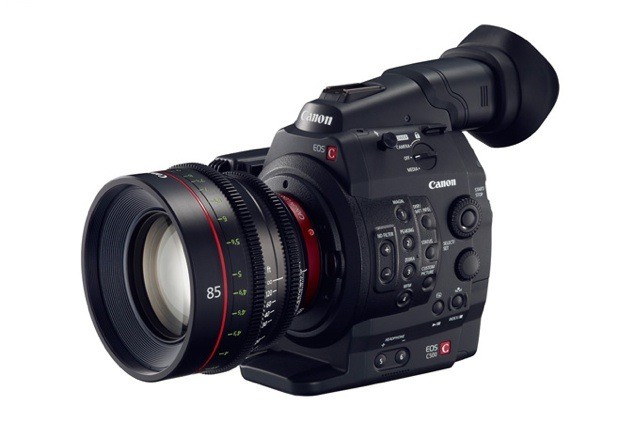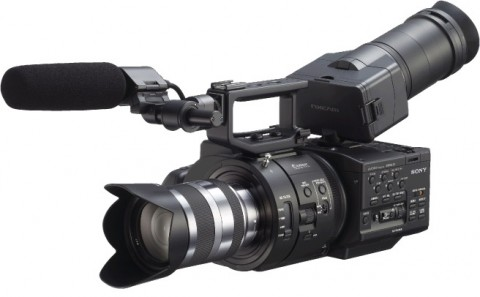4K Sets its Sights on Mainstream
As Canon adds the $30k C500 to its Cinema EOS line and the $15k EOS-1D C to its DSLR offerings, and Sony unveils the $10k NEX-FS700—a 4k-capable stablemate to the FS100—4k edges into the realm of broadcast and indie film budgets and the reach of a wider range of commercial production pros
Page 1
4K is coming. NAB is awash with tools for acquiring, storing, post producing and displaying resolutions four times greater than HD.
Peter Jackson's The Hobbit was shot on multiple Red Epics at 5K and Will Smith sci-fi vehicle After Earth, from director M. Night Shyamalan (The Sixth Sense), is one of the first productions to use Sony's F65 which outputs 4K from an 8K chip.
4K is now set to hit the mainstream with Sony and Canon among a string of manufacturers announcing product that brings the imaging capability within the realm of broadcast and indie film budgets.
Canon is to bring out the C500, shown in prototype at NAB, which is a 4K- and 2K-capable model in its Cinema EOS line with a "to be confirmed" price of $30,000. It also has a new digital SLR camera with 4K support, the EOS-1D C, priced at $15,000.
Meanwhile Sony is debuting a $10,000 4K-capable camera with a super slow motion mode ideal for pop promos, commercials, documentaries and sports. Available in June, the NEX-FS700 is initially intended for HD use but will be able to output 4K by way of a firmware upgrade and recorder at a later date.
Other camera vendors with 4K plans include Weisscam, which announced plans to release a 4K model capable of 450fps high-speed shooting; Panasonic, which has a prototype and no release date for a 4K model of its Varicam; and JVC, which is marketing a camcorder sporting a 4K-ready sensor.
Specs on the Canon C500

The C500 ups the resolution from Canon's HD digital cine camera C300, to output 10-bit 4K (4096×2160) raw files to an external recorder via dual 3G-SDI output.
AJA has built the first recorder, the Ki Pro Quad, which takes in the RAW camera output from the C500 and simultaneously outputs that data via Thunderbolt. The recorder also performs debayer processing of the RAW data that can be used to produce on-board Apple ProRes recordings to SSD media. The debayered image produced by the Ki Pro Quad can also be used for 4K monitoring in real time.
The camera enables frame rates up to 120fps and can simultaneously record at 50Mbps HD video making it compatible with many HD broadcast delivery specs, or for offline editing purposes.
The camera will have a new "Super 35mm-equivalent" CMOS, raising the resolution from 8.3 megapixels in the C300 to 8.85 megapixels. It is available in two versions: one with Canon's EF lens mount and one with a PL Mount.
Specs on the Sony NEX-FS700

The NEX-FS700 has a Super 35mm-sized CMOS sensor and is capable of capturing 480 fps and 960 fps at reduced resolution. It will deliver Full-HD quality images at 120 and 240 fps in an 8 or 16 seconds bursts.
The NXCAM's E-Mount will accept mosts SLR and DSLR 35mm lenses. The camcorder also includes face detection and auto focus to help ensure the subject is always kept in focus.
Users can save up to 99 camcorder profile settings on a memory card and can copy the same setting to multiple units. Compatible media includes MS and SD memory cards and Sony's HXR-FMU128 flash memory unit that attaches to the camcorder.
Sony is planning a future firmware upgrade that will enable the NEX-FS700 to output 4K bit-stream data over 3G HD-SDI when used with an optional Sony 4K recorder.
4K to the Home
A number of manufacturers—including Barco, Toshiba, Samsung, and TVLogic—are showing 4K monitors for the set, the edit room, and the home. Canon also previewed a 30" 4k reference display. Sony has a 4K-ready home projection system as well as a lead in 4K theatrical projection installations while RED is also to debut a 4K home theater system—even though content released in the format is limited.
A number of films, including the forthcoming Spider-Man and Skyfall, will be distributed in 4K, and live theater and music performances are being trailed in 4K for archive.
Just now, the main reason to shoot 4K is for the increased detail it provides the editing and compositing process, where any manipulation of the image decreases the origination quality.
Although broadcasters have barely settled their investments in HD production and transmission equipment, there will inevitably be a leap in broadcast resolution. The NHK-backed Super Hi-Vision is most notable. It packs a resolution sixteen times higher than HD—7680 x 4320 pixels—with tests during the London Olympics and a satellite broadcast trail set for 2015.
Standards body the ITU is drafting parameters for a UHDTV signal format which includes a 16x9 aspect ratio, progressive only, 10 and 12 bits of precision and framerates up to 120fps.
MPEG HEVC, expected to be ratified as an international standard this July, will also support UHDTV but limited to 8 bits in the initial version.
Whether at some point the human eye becomes incapable of resolving 8K, 16K, or more of pixelated information is a moot point. Just as 720p and 1080i tape then 2K files were moments in time, so historians of the future will consign 4K and 8K to evolutionary stages. Indeed we are at the tipping point which will make 4K capture, post and distribution the norm within a few years.
"We are five minutes away from that happening, and NAB is going to show probably the highest concentration of 4K monitors ever," says Michael Cioni, CEO of Hollywood-based post-production house LightIron.
The limits of current technology may have been reached with pixels arrayed at 5-10 micrometres to achieve a dynamic range of 12-13 f-stops. Higher resolutions require a smaller pixel size, reducing dynamic range. Higher Dynamic Range (HDR) is possible with stills cameras where multiple exposures of one frame can be combined, but trickier to achieve with motion.
"We are trying to make HDR systems with multiple sensors or filters in front of a sensor with a different dynamic range for individual pixels," says Siegfried Foessel of Fraunhofer's Moving Pictures research body. "This should be possible within five years."
Page 1
Related Articles
An in-depth interview on Sony's new 4K-capable large-sensor camcorder that generated tremendous buzz at NAB 2012 in Las Vegas this week.